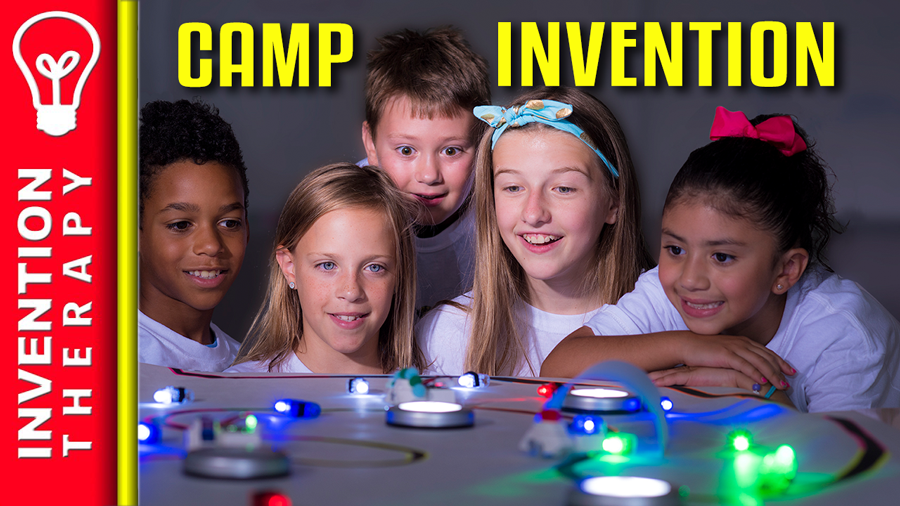Every child is creative and has a dream of becoming the hero who invents the next cure for cancer or a new form of green energy. Some children may want to invent a new musical instrument or send astronauts to the moon. Whatever their invention may be, it is essential to bring out the little creator in all of our children.
The Camp Invention program inspires our kids. It teaches kids how to invent. In my opinion, Camp Invention is a fantastic place to enroll your children over the summer because it will bring out the creativity and entrepreneur in them. It will also prepare them for school projects and homework to come. There are also some afterschool programs, depending on which camp adventure you choose.
When I was young, we didn’t have programs like this to help prepare us for our future. Regardless of your child deciding later in life to become a doctor or a plumber, the skills learned at places like Camp Invention can carry them their entire life.
Inventors like me have a different perspective on how the world works. We are always looking for answers to questions that may not seem evident at first. We also don’t always fit in with the rest of the crowd. If your child is the type that likes to spend time alone reading, studying, or even surfing the web, don’t assume this is a bad thing. To come up with new ideas, we must immerse ourselves in the world around us, but also retreat to solitude for inspiration.
As parents, we want our children to experience the world through human interaction. Physical presence these days seems to be becoming rare. Places like Camp Invention can help our children develop critical social skills that we all need.
The History of Camp Invention
The Camp Invention program began courtesy of the National Inventors Hall of Fame in 1990. There it started as an educational outreach program taught in just two different schools. However, in 1999, the United States Patent and Trademark Office decided to work with the Camp Invention program and brought it to many different schools nationwide. This partnership increased the camp’s popularity and gave children all over the United States the chance to enroll.
The camp came about to inspire young creators and inventors, allowing them to learn about innovation and teamwork. The program is all about building confidence by allowing hands-on experience in innovation. These crucial skills will carry on with them throughout their teenage years and even into their adult lives.
The Camp Invention Philosophy
“Every child can invent if given the opportunity and hands-on experience.”
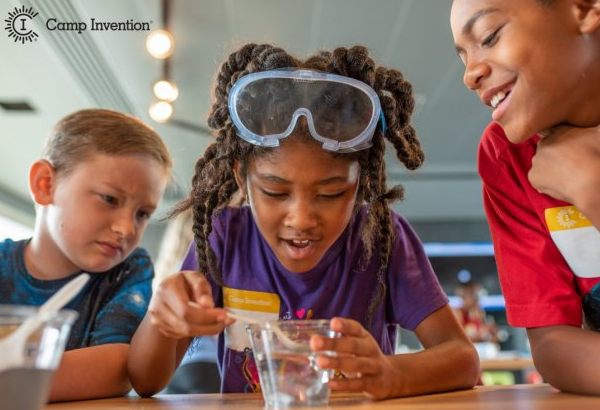
Inventor programs offered at Camp Invention
- Invention Playground For Preschoolers
- Camp Invention K-6
- Accelerate Camp Invention K-6
- Club Invention 1st through 6th grade
- STEM Maker Lab 1st through 6th grade
- Invention Project 6th through 9th grade
- Leaders-in-Training 7th through 9th grade
As briefly mentioned before, most of the Camp Invention programs are for children in elementary and middle school. There is at least one program that 9th graders can attend. There are also some limited programs available for even older kids!
I can tell you from experience that I began experimenting with things at a very young age. It was not uncommon for me as little more than a toddler to start trying to take apart my toys. By the time I was seven or eight, I would build simple electromagnets and flashlights with batteries and paper clips.
As an inventor, math, and science are crucial skills. Camp Invention’s focus is on STEM education along with innovation. STEM Education is used to group academics, allowing you to learn all four subjects in just one course. The disciplines include Science, Technology, Engineering, and Math (STEM). Sometimes Computer Science can be included as well.
For parents wondering about the quality of a Camp Invention program in their area, I would suggest the following:
- Look for projects that focus on creativity as well as technology.
- Computer science is a must. Projects like Lego Mindstorms, Arduino, and others are essential.
- While art is a vital part of my life as an inventor, this should not be the primary concern for parents trying to teach kids about invention.
- Kids learn math, science, and art during the regular school year. The Camp Invention program should be different.
Here are some of the programs, courses, and lessons offered at Camp Invention schools across America.
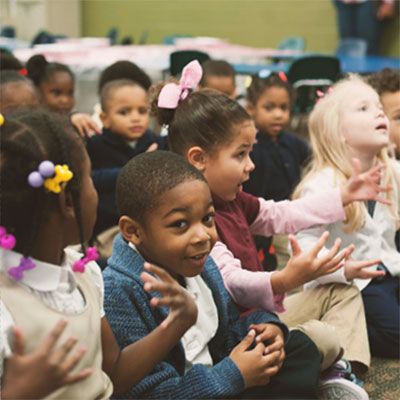
Invention Playground For Preschoolers
Preschool-aged children are always naturally curious and are super impressionable. This age is the best time to introduce them to a world of creating and inventing.
Attributes and Lessons taught in the classroom
- Creative Thinking
- Hands-on Activities
- Immersive Storylines
The motto for Invention Playground is “it is never too early to explore STEM.” Introducing your children to this type of education at such a young age could potentially ignite that fire to their creative side for years to come.
Lessons for Invention Playground
- Pod Pals Cruise the Galaxy: Children learn about the galaxy, gravity, inventing, building spaceships, building tall towers, and more!
- Shake, Rattle, and Roll: Children will learn about vibrations and sound waves, experimenting with instruments and megaphones!
- ZOOM: Children learn about STEM careers such as a chemist, architect, veterinarian, and rocket scientist.
- Mystery Present: Children will learn how to solve and discover mysteries, the science of bubbles, buoyancy, and circuitry.
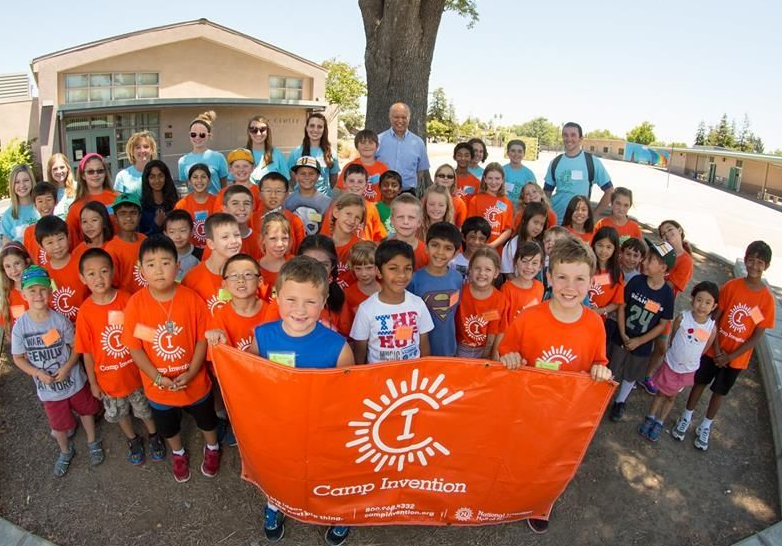
Camp Invention K-6
Camp Invention K-6 consists of youngsters that are at a critical age in their learning development. Invention Campers know that by attending this program, they are going to build the confidence they need to start getting into innovative design and entrepreneurship. It can be intimidating at first to put their ideas out there. By teaching a child at a young age to seek the advice of others, we can build those critical skills for the future.
Attributes and Lessons taught in the program:
- Creativity
- STEM interest
- Problem-solving skills
- Collaboration
Lessons learned at Camp Invention K-6
- Camp Invention Flight Lab: Children learn about putting all things into “flight” (gliders, paper planes, hand-rockets, etc.) They also learn about building cityscapes and taking apart robots.
- Design Thinking Project: Children learn to market products, design logos, create sketches, and become a successful entrepreneur and businessperson.
- Rescue Squad: Children will learn about helping wildlife, energy conservation, eliminating pollution. They also compete in zip line races, not just for fun, but also for gaining endurance!
- Camp Invention Champions: This is a program where children learn about the inventors behind their most favorite sport. They implement some of their own similar but original ideas. They also try to make up a whole new sport.
Accelerate Camp Invention K-6
Accelerate camp Invention K-6 is an extension of the Camp Invention course mixed with some school work to prepare for the next school year. Your children will be able to take their new design, mechanical, math, and science skills and bring that knowledge to the classroom. From there, they can continue to build their unique skills as an inventor.
Attributes and Lessons taught in the program:
- Mathematic skills
- Literacy skills
- Writing skills for school
- Problem-solving
- STEM interest for the future
- Creativity and innovation
I would hate to admit this, but I didn’t take my reading and writing skills serious as a child. I spent most of my time tinkering in the bedroom with electronic devices. As it turns out, my language skills are the most important of all. Writing this blog post is an excellent example as to why, as an inventor, your child will need these skills.
Other areas of discipline that I ignored at a young age but now regret are all the arts of language, music, sculpture, and painting. These are not natural skills to learn when you are older. While I did attend art school in Florence, Italy, later in my life, I should have taken them more seriously at a young age. I guess, like most people, I thought I knew better than my parents.
Club Invention 1st through 6th Grades
Club Invention is an excellent way to keep children inspired all year long. It allows them to keep thinking while working on their invention.
Club Invention 1st through 6th Grades is an after school program from Camp Invention. It caters to children just a tad bit older during the regular school year. All students in the 1st through 6th grades can enroll in this program, but they should try to take the summer program first.
Attributes and Lessons taught in the program:
- Inspiration from real-world inventors
- Confidence
- Taking on challenges
- STEM competency
- Fun-filled afternoons
- Innovation
When I was this young, the catholic schools I attended at the time did not have the necessary knowledge and tools to handle children like me. I found classes to be boring and useless as a child. While some of this was just my stubbornness at a young age, I could have benefited dramatically from programs like the ones from Camp Invention.
Lessons for Club Invention
- Boulder Builders: Students will help repair a town called “Unlucky” with a builder named Archie Tek. They will learn all about engineering and becoming an architect. Students will build homes for the townspeople and safe habitats for animals.
- Castles, Catapults, and Coats of Arms: This module is more of a history lesson in entrepreneurship and innovation. Students get a feel of the way things began. They will learn what it was like to be a Knight, Lord, and Craftsperson.
- E.Z. Science: Young Entrepreneurs and Inventors use a magazine they write to help solve mathematical and scientifical equations. They create games, solve puzzles, conduct experiments, and more to test out solutions to everyday problems.
- Flight Sight: This lesson and module are all about flying planes and how flight makes you see the world from different perspectives. Students will also create 3D maps, help with designing and flying huge paper planes. Some classes have also created a device that makes people jump higher.
- Passage to Planet ROG: Students travel to a distant planet named ROG. While on ROG, they must come up with ideas and inventions to sustain and live in space. This class is more about teamwork and innovative ideas.
- Phys. Ed: Physics in Motion: Students study science, scientists, gravity, energy, motion, and magnetism and find out why (and how) things move. They also create games based on these famous scientists that they admire.
- SOS: Endangered Earth: Students learn about how technology is helping to save the planet. They investigate some of the threats to animals and other life on earth. They invent safe spaces for animals, including black bears, blackbirds to black snakes.
- Trash Island: Students take on challenges and provide solutions about the trash buildup in the Pacific Ocean. Participating in this module for students is probably one of the most environmentally friendly things they will participate in at this young age!
- Echo and Axon: A Prototyping Adventure: Students will create solutions to STEM challenges that were inspired by actual real-life inventors! Try to rescue Echo and Axon with mathematics.
- The Wheel of Invention: A ‘game show’ where students will participate in “Entrepreneurial Game Arena.” Students will also present invention ideas and prototypes to try and “wow” the audience watching the game show.
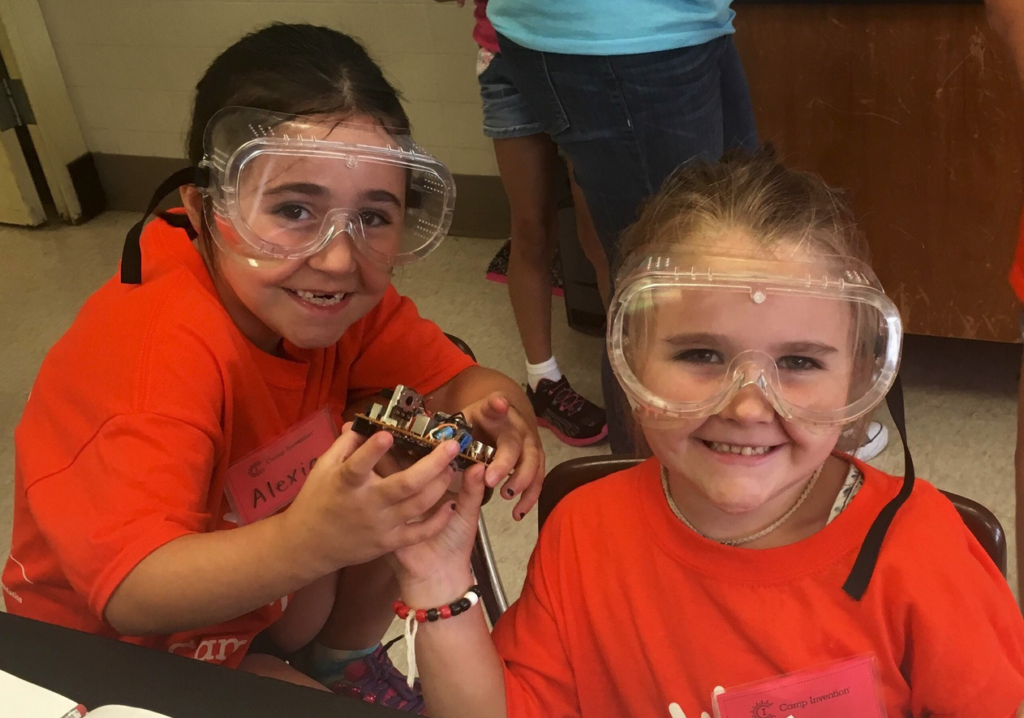
STEM Maker Lab 1st through 6th Grades
This particular program builds a much more in-depth knowledge of STEM, and this is the foundation of your tiny creator’s career!
Attributes and Lessons taught in the program:
- Hands-on problem solving
- Building an Entrepreneurial spirit
- Experimenting with new inventions and creations/ideas
- Growing in your knowledge of innovation
- Establishing a connection with your passion for Inventing
STEM Maker Lab is one of the more empowering programs in the Camp Invention curriculum. You can enroll your child in a local afterschool program or sign them up for a course from their existing classes.
Depending on the curriculum, this course is one of my favorites. Being able to make actual physical objects is a critical part of being an inventor. We are not talking about art projects here. The types of things we should be making should be more about real-world applications from the child’s imagination.
Things Invention class like this should teach:
- How to sketch or draw an invention idea.
- Create simple models or prototypes.
- Understand the functions of a 3D printer.
- How to use simple tools like screwdrivers, plier, and hammers.
- Learn the meaning of an invention idea?
Lessons for STEM Maker Lab
- Inspiration: Students will learn about brainstorming and then applying the power of creative thinking to solve real-life issues
- Creation: Students will build prototypes, testing different materials, then modifying as needed
- Intellectual Property: Students will learn about creating logos, brands, and names for their products or ideas. They will also learn about how to protect their ideas.
- Tech Tools: Students will learn to use different technology and tech tools, such as microphones, 3D Printers, and various computer software programs.
- Marketing: Students will learn how to design their product, and also how to market and promote their product – learning about all of the various tools there are to market
- Entrepreneurship: Students can create their products/ideas as if they were putting them out on the market. They then come up with a business plan, pitch, market, and then present the product for sale.
STEM Maker Lab at Camp Invention interests me the most. As an inventor, I try to teach about the importance of picking ideas that other people will want to use. While it may seem advanced for your youngsters to think of inventions this way, it will help them look at things very differently. Ideas can’t impact the world if they don’t have some foundation in reality. If you look at my Twelve Steps Of The Invention Process, you will see that many key points are covered by Camp Invention.

Invention Project 6th through 9th Grades
Strictly made for middle-schoolers, these high-energy, hands-on activities are sure to spark the flame of any pre-teen and teenage inventor. The Invention Project is one of the most empowering of all the classes. It positively pushes the students to keep their invention dreams alive. The course is there to teach them to dig deep inside of their entrepreneurial spirit.
Attributes and Lessons taught in the program:
- Real-world skills
- Building an Entrepreneurial spirit
- Collaborating with teammates
- Empowering self-expression
- Establishing a connection with turning ideas into inventions
Lessons for Invention Project
- Mini-bot: Students will learn about circuitry and counterbalance while designing their own motor-powered devices.
- Extreme Shoe: Students will build innovative shoes while considering features, pricing, and business opportunities.
- Video Game Design: Students will learn to promote health and wellness through video games.
- Tech Messaging: Students work together to figure out any issues or loopholes. They learn the power of communications and technology to help the process of invention.
Leaders-in-Training 7th through 9th Grades
As a leader-in-training, your child is a role model for the younger generation of inventors. Older students will be there to help mentor newer inventors by answering questions, helping with ideas, and so much more.
Attributes and Lessons taught in the program:
- Certification
- Mentorship
- Inspiration
- Collaboration
- Empowering the younger inventors
- Establishing a connection with younger inventors
Think about how great that will look on college applications! Your child will already have experience in managing little Einstein’s!
Leadership Interns High-school and College age
Much like the leader-in-training role, your child is the mentor for those younger kids looking to become an inventor. However, they aren’t just helping the younger inventors, but also learning how to be leaders! Your role is super important and essential because, without this opportunity, there might not be any mentors or successful inventors at all!
Attributes and Lessons taught in the program:
- Learn, Inspire, and Succeed
- Building an Entrepreneurial spirit
- Collaborating
- Receive Exceptional training
- Gain valuable experience
- Help other young inventors succeed with your training
This role is strictly for high school (10th through 12th grades) and then also those in college. It is a voluntary position. Every little creative mind needs some help from an experienced, more experienced person. Maybe your child wants to help someone out this summer. Did you know that Braille was invented by a blind, 12-year-old boy.– How inspiring would that feel to know maybe your child helped with something as amazing as that?
Professional Development For Educators
Just because you are already a STEM teacher, don’t assume that you have the knowledge necessary to guide children as young inventors. Inventors are usually the children in your class that are the most misunderstood. We can all use a little more knowledge when dealing with the multitudes of personalities found in the classroom.
Attributes and Lessons taught in the program:
- Innovative Professionalism
- Research-based strategies
- STEM-focused/Knowledgable with STEM
- Customized workshops
- Create more engaged students
This curriculum is strictly for those who have already been noted as established, professional educators. It is for teachers that would like to know more about STEM and how to conduct more engaging educational programs. Become an educator that knows his or her stuff when it comes to innovation, inventing, entrepreneurship, STEM, workshops, and more! The best part is that you will mentor and help young inventors while learning more ways to help improve the futures of all your students.
Locations, Costs, and Schedule
Try to remember that the purpose of Camp Invention is to bring out the little inventor and creator in your child. Let them choose the programs that they find the most interesting.
Locations
The location of Camp Invention is in over sixteen hundred areas nationwide. The best way to find the place nearest you is to search the Camp Invention map located HERE.
Costs
The cost of the camp will vary depending on which classes your child is attending. You will be able to see all of this information before you pay for the registration fee. Visiting the link above will allow you to enter your city, state, and zip code of choice. It will help you locate the best courses for your child. Prices and dates are also listed.
Typically each program ranges between $250-$300 per a four to five-day camp experience. The total class time is around thirty to forty hours during those few days.
Schedule
Each schedule is different depending on which camp and curriculum you are choosing. It is best to visit the website invent.org for more detailed information.
Most of the programs take place in June or July. There are some afterschool programs as well. It is always a good thing to call or visit the site and check what is perfect for you and your child!
Conclusion
I hope that this article helped explain more about the Camp Invention programs from an actual inventor’s perspective. As I mentioned, I wish we had these types of opportunities when I was a child.
It is vital to capture your child’s imagination at a young age and allow him or her to develop it further over time. Very few people become inventors as a full-time career. This doesn’t mean that your child won’t learn how to invent something new that people will want to use in their lives. Discovering new ways to look at things is an essential skill that we all must learn. The world is changing fast, and the more skills we can add to our children’s toolboxes, the better off they will be prepared for the future.

Are you ready to become an inventor?
Getting your idea out of your head and into your hands is only the first in a long set of steps towards becoming a successful inventor.

First Steps To A Successful Invention
At Invention Therapy, we believe that the power of the internet makes it easier than you think to turn your invention idea into a reality. In most cases, you can build a prototype and start manufacturing a product on your own. Changing your way of thinking can be difficult. Being an inventor requires you to balance your passion with the reality of having to sell your products for a profit. After all, if we can't make a profit, we won't be able to keep the lights on and continue to invent more amazing things!Please subscribe to our Youtube Channel!


